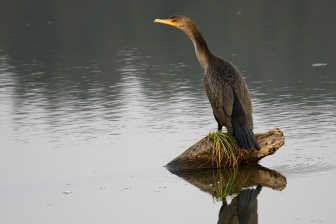forum
library
tutorial
contact

Corps Declares War on
Lower Columbia Cormorant Colony
by Bill Rudolph
NW Fishletter, June 26, 2014
|
the film forum library tutorial contact |

|
Corps Declares War on
by Bill Rudolph
|
 The U.S. Army Corps of Engineers is calling for public comment on the draft EIS for its plan to reduce double-crested cormorant predation on juvenile salmonids in the Columbia River Estuary.
The U.S. Army Corps of Engineers is calling for public comment on the draft EIS for its plan to reduce double-crested cormorant predation on juvenile salmonids in the Columbia River Estuary.
The plan's preferred alternative calls for "culling" up to 20 percent of the cormorant population for several years from the birds' nesting site on East Sand Island, in order to whittle the colony's size down to 5,600 breeding pairs, from nearly 15,000 pairs in 2013.
The culling would be done by shotgun, rifle, or trapping by net and euthanasia, and would be supported by a limited egg-take, along with land- and boat-based hazing to keep the birds from relocating to other parts of the estuary. The island would also be reduced in size.
Other possible alternatives call for cutting the size of the cormorant colony by "primarily" non-lethal means, or the most draconian action of all, ending all nesting at East Sand Island. A no-action alternative would not satisfy an action mandated by the hydro BiOp that calls for reducing avian predation in the lower river.
In recent years, biologists have estimated the cormorants have consumed more than 18 million smolts annually, including about 3.6 percent of the juvenile steelhead migration. According to the draft plan, if no action is taken, predation by the colony "would likely continue to result in a loss of up to $21 million in direct financial investment in hatchery production and potential annual losses of $2.7 million to in-river Columbia River fisheries."
The draft plan says by reducing the colony to 5,600 breeding pairs (about one-quarter of the total western population), the predation rate would drop enough to satisfy the survival gap pegged by NOAA Fisheries, and boost survival of juvenile salmonid stocks by 1-4 percent, depending on the evolutionarily significant unit.
The Audubon Society of Portland released a statement on June 13 strongly opposing the proposal. "It is time for the Army Corps to do a ground-up review of its entire approach to managing birds in the Columbia Estuary. The focus should be on addressing the primary causes of salmon decline: dam operation and habitat loss."
Related Sites:
"Columbia River Basin Salmon and Steelhead Long-Term Recovery Situation Assessment Final Report" (1.9 Mb pdf) by The William D. Ruckelshaus Center and Oregon Consensus
learn more on topics covered in the film
see the video
read the script
learn the songs
discussion forum
